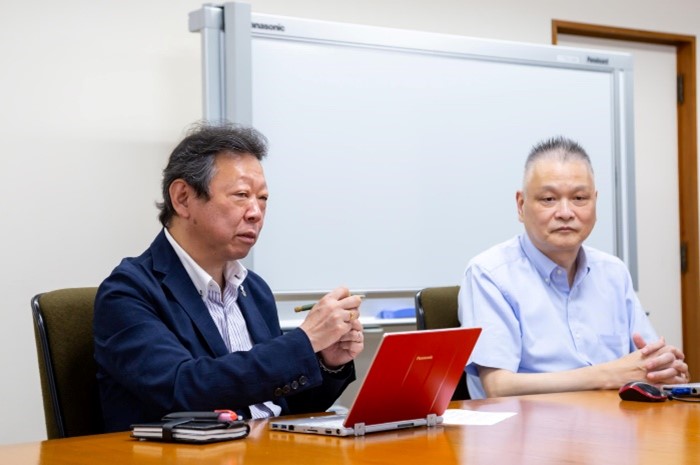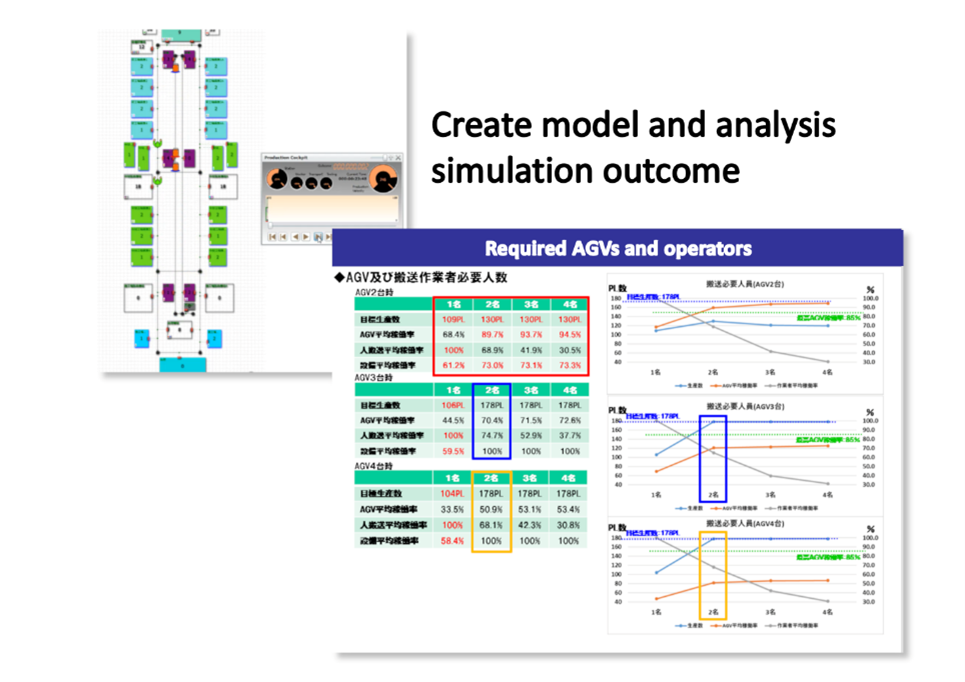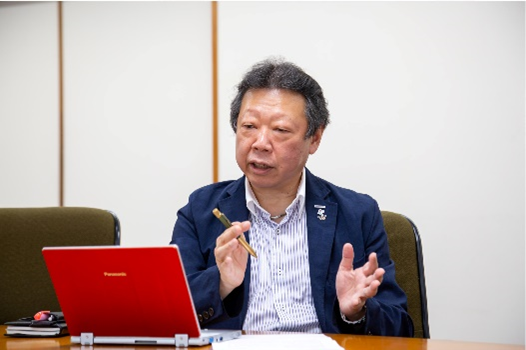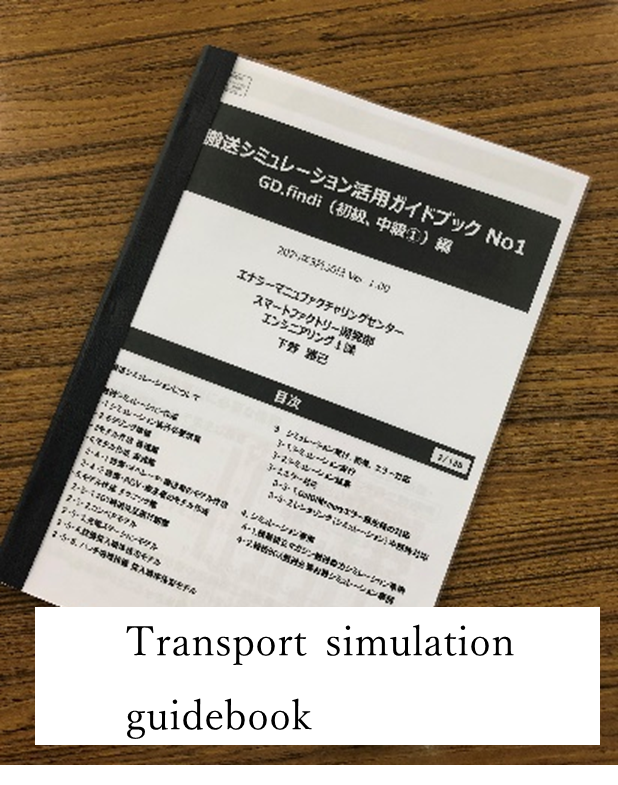Case: Panasonic Corporation
- Home
- /
- Newsroom
- /
- case
- /
- GD.findi MS
- /
- Panasonic Corporation
Panasonic is introducing GD.findi as a cyber-physical system to their production line.
A major change is taking place at Panasonic manufacturing plant. By using a production simulator, the company is working on how to improve speed and quality innovatively. In the battery business, the company is using GD.findi, a production simulator, to propose automated guided vehicles (AGVs) for factory lines. The company formulated an implementation plan and proposed to each factory in one-tenth of the time it would have taken previously, and within a year of implementing the system, it was able to complete 10 cases at four factories.

GD.findi is a powerful tool that can specify various conditions dynamically in your factory.
The Manufacturing Innovation Division is the driving force behind Panasonic Smart Factory initiative, which was established in 1963 from the Production Technology Research Laboratory, and has contributed to business expansion through the development of unique production equipment and other production technologies. Currently, it is also working on the digitization of manufacturing sites. “We have just under 300 factories globally, but many of them are small-scale and division-based, and are inefficient in some aspects. We will aim to build a cyber-physical system by changing the procurement, operation, and supply chain into a one-operation system using IT” said Mr. Tadashi Makihara, the chief engineer of the Next Generation Base Project in this division.
The company has been using simulators in the field of production processes for some time to digitize the manufacturing floor. However, the simulator for production process did not take root. We kept buying them and then not using them,” recalls Makihara.
That’s when I came across GD.findi five years ago. GD.findi was easy to implement because it is available via a browser as a subscription software. Also, since we can create models based on GUI without programming, we felt that even non-experts in the field can use it,” said Mr. Makihara, describing his first impression of GD.findi.
Since then, the company has proposed GD.findi to various production plants, including production lines for products that need to be customized by users and for verifying process designs to cope with fluctuations in production volume. For the battery business unit, which is currently achieving great results, we have accelerated the introduction of the system by utilizing the MI Division’s system in the cloud and integrating our knowledge.

“GD.findi can quickly produce highly accurate output by reusing the model. We believe that GD.findi is a powerful tool for specifying various conditions and data dynamically.” said Mr.Makihara.
What Mr. Makihara is currently focusing on is the implementation of simulation for cooperation with overseas factories. Under the situation of Covid-19, it becomes difficult for engineers in Japan to go to overseas factories for supervising purpose. Therefore, they use GD.findi to conduct precise simulations and use the results to guide them in planning and designing production lines.
“By using simulation as a communication tool, we can have more logical discussions, and we are positioning GD.findi as one of the tools for cyber-physical systems,” said Mr.Makihara.GD.findi aims to strengthen the company’s fundamental ability by increasing its engineering power from the bottom up.
Using simulation to realize optimization for battery factories.
By using GD.findi to accelerate the implementation of AGVs in the factories, the battery business unit is achieving great results. The company has a long tradition in the battery business, but they were under pressure to improve the efficiency of their production lines and reduce manufacturing costs. This is where the use of AGVs, Automated Guided Vehicles, came into the picture. “AGVs are an important solution from the perspective of labor saving. However, we often find the return on investment is not worth it if we try to introduce them in the shadows” said Mr. Satoshi Yamamura, General Manager of the Smart Factory Development Department and in charge of enhancing manufacturing capabilities at the Energy Manufacturing Center.
In order to ensure that the implementation of AGVs would lead to enhanced manufacturing capabilities, Mr. Yamamura decided to bring in simulation. By running simulations beforehand, they can optimize their operational design and provide evidence to verify the results after the implementation. That is why they decided to use GD.findi.
Mr. Yamamura used to belong to the same Manufacturing Innovation Division as Mr. Makihara, and was promoting GD.findi. “The interface is easy to understand and intuitive to use, and I feel that the advantage of GD.findi is that it allows us to make a speedy outlook rather than bringing us closer to the real workplace.” said Mr.Yamamura.
Once the layout and operations are decided, AGVs can be implement in the plant in six months, even for those existing factories that already have production lines. Speeding up the process from proposal to operation design will lead to a shorter overall schedule, which in return will lead to greater benefits from the implementation.
In fact, the power of GD.findi was immediately noticeable. Mr. Masami Shimono of Engineering Section 1, Smart Factory Development Department, who was in charge of making proposals to factories using GD.findi, started using GD.findi in May 2018 and was able to make the first proposal by the end of June. The target was to design the optimal number of AGVs, the optimal number of personnel and the optimal number of inventory quantity for a new production line.
“We run a simulation with 2 to 4 AGVs and 1 to 4 workers to find out the optimal number of AGVs, the number of workers, and the maximum number of inventory quantity required for product storage. I think we were able to make a convincing proposal by showing the simulation video and graphs of the calculation results” said Mr. Shimono.

Reduce the time to one-tenth of the conventional proposal.
Mr. Yamamura and Mr. Shimono continued to make proposals for the implementations of AGVs using GD.findi, and in one year they made proposals for 10 cases in four factories. They investigated the current situation and input data into the model. The number of AGVs varied from 1 to 12, and the system was also applied to transport units between buildings. At the beginning, it was sometimes difficult to create the model as we wanted, but we soon got used to it. The difficult part was deciding the target range based on the on-site interviews, and the appropriate level of granularity for the simulation. If it is too detailed, it may take too much time and produce no results,” said Mr. Shimono, explaining the key points in using the system.

A unique feature of the system is the effort to accumulate experience and know-how and utilized it in the next step. The company has compiled information on model creation, simulation execution methods, and case studies in the “Guidebook for Using Transport Simulation” to expand the scope knowledge of users within the company. At the same time promoting to reuse of the models created so far. If models can be reused, the proposal cycle can be shortened.

“The important thing is to make proposals in a speedy manner. The simulation itself takes less than two days. This is one tenth of the time it used to take. Thanks to this, the average time it took us to compile an internal proposal was reduced from one month to about two weeks. Ideally, we would like to be able to do this in real time, but we are aiming to reduce the time to about three days,” said Mr. Yamamura.
In the “Smart Factory Lab” located in the Energy Manufacturing Center, various types of AGVs have been implemented, and research on advanced manufacturing processes, such as combining AI technology with sensing, is being conducted. The ultimate goal is to create a cyber-physical system in the factory and realize a smart factory.
“We are currently using simulations to optimize the number of units and design production plan, but in the future we will use actual data from IoT and other sources to detect abnormalities on the production floor and verify improvement activities.GD.findi is a simulator, but if it can be linked to AI-based predictive monitoring, it will contribute to the digital transformation of the manufacturing industry,” said Mr.Yamamura.
